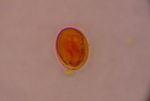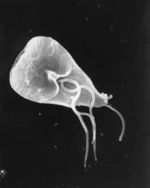Difference between revisions of "Giardiasis"
| Line 73: | Line 73: | ||
==References== | ==References== | ||
| − | *Papasouliotis, K and Gruffydd-Jones, T (1996) Practical Approach to Diarrhoes in the Cat. ''In Practice'', '''18(5)''', 206-214. | + | *Fisher, M (2002) Endoparasites in the dog and cat: 2. Protozoa. ''In Practice'', '''24(3)''', 146-153. |
| + | *Taylor, M A and Webster, K A (1998) Recent advances in the diagnosis of Cryptosporidium, Toxoplasma, Giardia and other protozoa of veterinary importance. ''Research in Veterinary Science'', '''65''', 183-193. | ||
| + | *Papasouliotis, K and Gruffydd-Jones, T (1996) Practical Approach to Diarrhoes in the Cat. ''In Practice'', '''18(5)''', 206-214. | ||
| + | *Tilley, L P and Smith, F W K (2007) '''The 5-minute Veterinary Consult (Fourth Edition)''' ''Blackwell Publishing''. | ||
*Rutgers, H C (1989) Diarrhoea in the Cat. ''In Practice'', '''11(4)''', 139-148. | *Rutgers, H C (1989) Diarrhoea in the Cat. ''In Practice'', '''11(4)''', 139-148. | ||
| − | |||
| − | |||
[[Category:To_Do_-_Lizzie]] | [[Category:To_Do_-_Lizzie]] | ||
[[Category:WikiClinical Canine]] | [[Category:WikiClinical Canine]] | ||
[[Category:WikiClinical Feline]] | [[Category:WikiClinical Feline]] | ||
Revision as of 17:31, 11 August 2010
| This article is still under construction. |
| Also known as: | Giardiosis Giardia Infection |
Description
Giardia is a binucleate, flagellate protozoa that causes enteric infection giardiasis in dogs and occasionally cats. Transmission is via cysts that are shed in the faeces, and may be direct or indirect. Indirect water-borne transmission is the most common modality and is favoured by cool, moist conditions that prolong cyst survival. Once cysts are ingested, motile trophozoites are released and attach to the cells of the small intestinal mucosa via an adhesive disc. Predilection sites in the dog are the duodenum and jejunum, where as only the duodenum is favoured in cats. Multiplication by binary fission can then occur, and trophozoites encyst to a stage adapted for survival in the external environment. Cysts are seen in the faeces from day 3 post-infection in dogs (5-16 in cats), and can survive in the environment for several months. Animals that mount an immune response to Giardia can eliminate infection; however, the immunity acquired does not necessarily prevent re-infection after a short period.
Giardiasis is a condition of significant zoonotic concern. Although the cat protozoa G. felis seems to be species-specific, dogs can host both the canine-specific G. canis and G. lamblia, which has zoonotic genotypes. It is not known how important dogs are as a reservoir for human Giardia infection, or how frequently zoonotic transmission occurs. In man, Giardia may cause acute diarrhoea, particualrly in immunocompromised individuals. Subclinical infections also occur.
Signalment
Dogs are more commonly affected than cats. There are no age, breed or sex predispositions for Giardia infection, but puppies and kittens are more likely to contract clinical disease than adult animals.
Diagnosis
Clinical Signs
Clinical signs are most likely to be seen in younger animals as older hosts are usually infected asymptomatically. Signs vary from acute diarrhoea to chronic loose, fould-smelling faeces, and frequency of defaecation is usually increased. Vomiting and weight loss may be seen in some cases. Malabsorbtion syndrome with soft, frothy, greasy, voluminous, malodourous faeces can occur.
Giardiasis may also cause malabsorption, and there are several proposed mechanisms for this. For example, the small intestinal villi may be grossly atrophies or damages ultrastructurally, or giardiasis may lead to bacterial overgrowth. There is also evidence that Giardia consumes bile acids, preventing digestion of fats.
Laboratory Tests
Haematology, biochemistry and urinalysis usually give results within normal limits.
Diagnosis is confirmed by demonstrating Giardia antigen, trophozoites or cysts in the faeces. The simplest method is to stain a fresch faecal smear with Diff-Quik or Lugol's iodine to reveal trophozoites. Giardia trophozoites are approximately 8 x 15 microns in dimension, tear-drop shaped organisms and contain two nuclei. They can be seen to move in a "falling leaf" pattern in wet mounts.
As cysts are relatively "heavy", cysts must be floatated in higher density solutions prior to visualisation. Suitable solutions include zinc sulphate solution and sugar flotation solution. Centrifugal flotation in zinc sulphate solution is preferred as cysts can be envisaged with minimal distortion. Cysts are around 12 microns long
- Faecal examination
- Cysts need to be distinguished from pollen grains and yeasts
- Cyst excretion is intermittent
- Faeces need to be collected over a 3 day period
- Cysts are heavy
- Needs higher density flotation fluids
- Do not float well in saturated sodium chloride solution
- Immunoassays
- Detect cyst antigen in faeces
Treatment
- Sanitation and hygiene
- Minimise risk of human infection
- Boil (or sterilise through other means) drinking water in regions of the world where drinking water may be contaminated
- Avoid uncooked foodstuffs
- Contaminated by washing
- Drug Treatments
- Metronidazole
- Flagyl, Torgyl
- Fenbendazole
- Panacur
- Metronidazole
- Vaccination
- Killed trophozoites
- Available in the USA for cats and dogs
- Decreases the excretion and viability of cysts
- Decreases environmental pressure
Prognosis
Links
References
- Fisher, M (2002) Endoparasites in the dog and cat: 2. Protozoa. In Practice, 24(3), 146-153.
- Taylor, M A and Webster, K A (1998) Recent advances in the diagnosis of Cryptosporidium, Toxoplasma, Giardia and other protozoa of veterinary importance. Research in Veterinary Science, 65, 183-193.
- Papasouliotis, K and Gruffydd-Jones, T (1996) Practical Approach to Diarrhoes in the Cat. In Practice, 18(5), 206-214.
- Tilley, L P and Smith, F W K (2007) The 5-minute Veterinary Consult (Fourth Edition) Blackwell Publishing.
- Rutgers, H C (1989) Diarrhoea in the Cat. In Practice, 11(4), 139-148.

